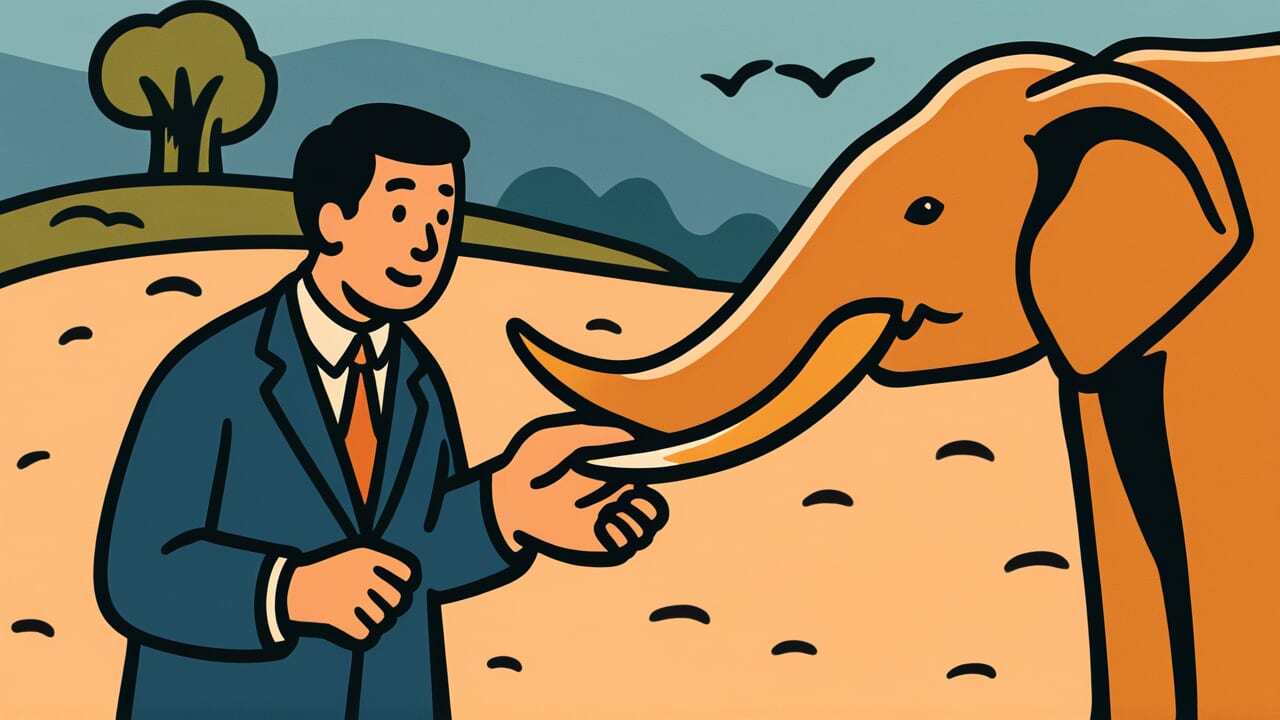How to Read “Seeing the elephant’s tusk, one knows it is larger than an ox”
Zō no kiba wo mite sunawachi sono ushi yori dai naru wo shiru
Meaning of “Seeing the elephant’s tusk, one knows it is larger than an ox”
This proverb means you can estimate the size or value of something by looking at just one part of it.
By observing only the elephant’s tusk, you can tell the elephant is much larger than an ox. This shows how examining one part reveals the whole.
People with sharp observation skills can grasp the complete picture from small clues. This proverb teaches the importance of such ability.
You don’t need to see everything to understand the essence or scale of something. Identifying the key parts is enough.
Even today, we often estimate the whole from limited information. We judge someone’s ability from one aspect of their character.
We assess a company’s overall health from one department’s performance. This way of thinking applies in these situations.
Even partial information can reveal the whole if it shows essential characteristics. This is the wisdom behind the proverb.
Origin and Etymology
This proverb likely comes from ancient Chinese classics. The phrase “Seeing the elephant’s tusk, one knows it is larger than an ox” has a classical Chinese structure.
It probably came to Japan through Chinese philosophy and literature rather than originating in Japan.
The observation is simple: just by seeing the tusk, you know the elephant is much larger than an ox.
For ancient people, elephants were rarely seen animals. But their enormous size was known through stories. Oxen, however, were familiar farm animals people saw daily.
This contrast carries deep meaning. The elephant’s tusk alone is larger and more impressive than an entire ox.
From this, you can imagine how massive the whole elephant must be. This logical thinking was valued in ancient Chinese philosophy and learning.
The ability to see the essence of things and sharpen observation skills was highly regarded. This proverb was born as a teaching about these qualities.
After reaching Japan, it continued to be used when teaching the importance of wisdom and insight.
Usage Examples
- After reading just the introduction of his paper, I understood the value of this research. It’s like “Seeing the elephant’s tusk, one knows it is larger than an ox.”
- Watching that new employee’s first presentation, I knew they’d become someone great. “Seeing the elephant’s tusk, one knows it is larger than an ox.”
Universal Wisdom
Humans have the power to see the whole from limited information. This proverb has been passed down through generations for a reason.
We constantly make judgments based on incomplete information in daily life. That’s simply how we exist.
Knowing everything before acting, seeing everything before judging—such ideal situations rarely happen in reality.
Instead, the ability to grasp the essence from small clues becomes the key to opening up life’s possibilities.
Skilled merchants judge value by examining part of a product. Expert doctors understand the full disease from a few symptoms.
Wise people comprehend someone’s character from a single word. This is the power of insight.
Behind this wisdom lies deep trust in human perception. Our brains have an amazing ability to infer the whole from parts.
At the same time, this proverb teaches humility. Judging without seeing everything assumes the visible part represents the essence.
That’s why choosing what to look at and where to focus becomes crucial. What you observe matters greatly.
Our ancestors embedded the importance of cultivating an eye for essence into this striking image. The contrast between elephant and ox makes it memorable.
When AI Hears This
The wisdom of estimating body size from an elephant’s tusk contains an important law biologists discovered in the 20th century.
It’s called “allometry”—when organisms grow larger, each body part doesn’t grow at the same rate as the whole body.
Let’s look at specific numbers. If an ox weighs 500 kilograms, an elephant weighs about 5,000 kilograms—ten times more.
If tusks were simply proportional to body weight, elephant tusks would be ten times the size of ox horns.
But in reality, elephant tusks are more than twenty times larger than ox horns. This happens because projections like tusks grow proportionally to about the 1.3 power of body weight, not the first power.
In other words, if the body doubles in size, the tusks become nearly 2.5 times larger.
This power law works because of mechanical constraints. Body weight increases with volume—length cubed.
But bone and tusk strength only increases with cross-sectional area—length squared. Larger animals need relatively thicker bones to support their weight.
Weapons like tusks similarly become thicker and longer. This is a fundamental principle of biomechanics.
Ancient Chinese observers recognized this non-linear relationship without mathematical equations. They noticed that the elephant’s tusk was unexpectedly massive.
From this, they could accurately estimate the scale of the entire body. This is exactly the scaling theory modern biologists use today.
Lessons for Today
Modern society is called an age of information overload. But actually, the truly necessary information is limited.
This proverb teaches us not to try knowing everything. Instead, cultivate the power to identify essential parts.
When you evaluate people, judge a project’s potential, or decide whether to take on a new challenge—you don’t need to wait for all information.
What matters is having the eye to recognize what represents the essence, the “elephant’s tusk.”
This ability develops through experience and repeated observation. By practicing judgment with limited information without fearing failure, your insight will surely grow.
However, don’t forget humility. Always question whether what you’re seeing truly represents the whole.
Maintain this attitude of self-reflection. It keeps your judgment sharp and accurate.
Don’t drown in the sea of information. Cultivate an eye that sees the essence.
This will become an irreplaceable power that makes your life richer and more fruitful.



Comments